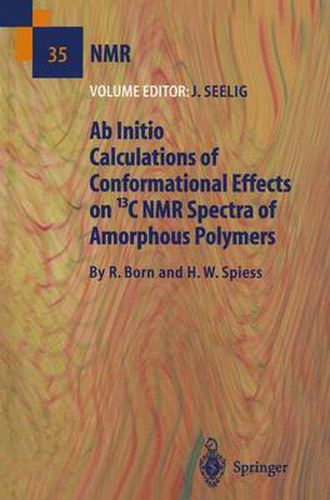Readings Newsletter
Become a Readings Member to make your shopping experience even easier.
Sign in or sign up for free!
You’re not far away from qualifying for FREE standard shipping within Australia
You’ve qualified for FREE standard shipping within Australia
The cart is loading…






This title is printed to order. This book may have been self-published. If so, we cannot guarantee the quality of the content. In the main most books will have gone through the editing process however some may not. We therefore suggest that you be aware of this before ordering this book. If in doubt check either the author or publisher’s details as we are unable to accept any returns unless they are faulty. Please contact us if you have any questions.
In NMR, it is well-known that the chemical shift conveys structural informa tion, e. g. a carbonyl carbon will have a resonance frequency appreciably dif ferent from a methyl carbon, etc. The relation between structure and chemical shift is mostly established by empirical rules on the basis of prior experience. It is only quite recently that the advent of both comparatively cheap comput ing power and novel quantum chemistry approaches have provided feasible routes to calculate the chemical shift at the ab initio level for molecules of reasonable size. This raises the question whether application of these novel theoretical concepts offers a means of obtaining new structural information for the complex chain molecules one deals with in polymer science. Solid state 13C-NMR spectra of glassy amorphous polymers display broad, partially structured resonance regions that reflect the underlying disorder of the polymer chains. The chemical shift responds to the variation of the ge ometry of the chain, and the broad resonance regions can be explained by an inhomogeneous superposition of various chain geometries (and thus chem ical shifts). In this review, we present a novel approach to combine polymer chain statistical models, quantum chemistry and solid state NMR to pro vide quantitative information about the local chain geometry in amorphous polymers. The statistical model yields the relative occurrence of the various geometries, and quantum chemistry (together with a force field geometry op timization) establishes the link between geometry and chemical shift.
$9.00 standard shipping within Australia
FREE standard shipping within Australia for orders over $100.00
Express & International shipping calculated at checkout
Stock availability can be subject to change without notice. We recommend calling the shop or contacting our online team to check availability of low stock items. Please see our Shopping Online page for more details.
This title is printed to order. This book may have been self-published. If so, we cannot guarantee the quality of the content. In the main most books will have gone through the editing process however some may not. We therefore suggest that you be aware of this before ordering this book. If in doubt check either the author or publisher’s details as we are unable to accept any returns unless they are faulty. Please contact us if you have any questions.
In NMR, it is well-known that the chemical shift conveys structural informa tion, e. g. a carbonyl carbon will have a resonance frequency appreciably dif ferent from a methyl carbon, etc. The relation between structure and chemical shift is mostly established by empirical rules on the basis of prior experience. It is only quite recently that the advent of both comparatively cheap comput ing power and novel quantum chemistry approaches have provided feasible routes to calculate the chemical shift at the ab initio level for molecules of reasonable size. This raises the question whether application of these novel theoretical concepts offers a means of obtaining new structural information for the complex chain molecules one deals with in polymer science. Solid state 13C-NMR spectra of glassy amorphous polymers display broad, partially structured resonance regions that reflect the underlying disorder of the polymer chains. The chemical shift responds to the variation of the ge ometry of the chain, and the broad resonance regions can be explained by an inhomogeneous superposition of various chain geometries (and thus chem ical shifts). In this review, we present a novel approach to combine polymer chain statistical models, quantum chemistry and solid state NMR to pro vide quantitative information about the local chain geometry in amorphous polymers. The statistical model yields the relative occurrence of the various geometries, and quantum chemistry (together with a force field geometry op timization) establishes the link between geometry and chemical shift.